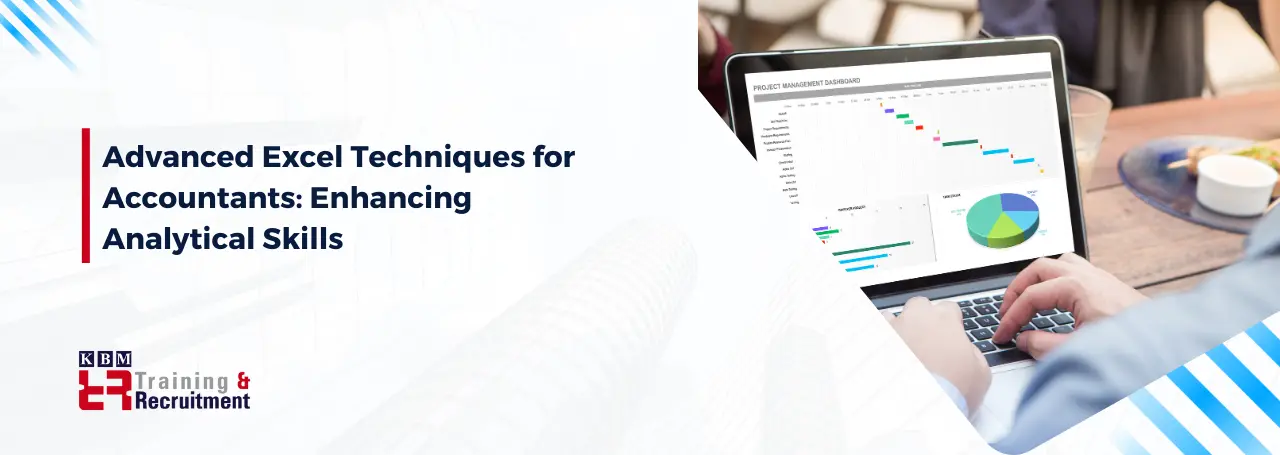Excel has long been a staple tool for accountants, but mastering advanced techniques can significantly elevate the analytical capabilities of finance professionals. This blog will explain advanced Excel techniques tailored for accountants, exploring how these skills can enhance data analysis, reporting, and overall efficiency in financial tasks.
1. PivotTables for Dynamic Data Analysis
- PivotTables: PivotTables are powerful tools in Excel that allow accountants to summarise, analyse, and manipulate large datasets. They provide a dynamic way to organise and extract meaningful insights from financial data.
- Application in Accounting: Accountants can use PivotTables to quickly analyse transactions, track expenses, and summarise financial information. The ability to pivot data based on various dimensions provides a flexible and efficient approach to financial analysis.
2. Power Query for Data Transformation
- Power Query: Power Query is an Excel add-in that empowers accountants to connect, transform, and cleanse data from diverse sources before importing it into Excel. It provides a robust solution for managing complex data transformation tasks.
- Application in Accounting: Accountants can automate importing and cleaning data from diverse sources using Power Query. This ensures data consistency, reduces errors, and streamlines the workflow when dealing with large datasets from different financial systems.
3. Dynamic Dashboards with Data Validation
- Dynamic Dashboards: Dynamic dashboards provide a visually appealing and interactive way to present financial information. They allow accountants to create user-friendly reports that update in real time based on user inputs or changes in underlying data.
- Application in Accounting: Accountants can build dynamic dashboards to showcase vital financial metrics, budget comparisons, or performance indicators. By incorporating data validation, users can interactively filter and analyse specific aspects of financial data, enhancing the decision-making process.
4. Advanced Formulas: INDEX-MATCH, OFFSET-MATCH
- INDEX-MATCH Formula: The blend of INDEX and MATCH is a potent alternative to VLOOKUP. It enables accountants to locate a value in a specific column and retrieve a corresponding value from another column, providing greater flexibility and precision.
- OFFSET-MATCH Formula: The OFFSET-MATCH combination is helpful for dynamic data ranges. It allows accountants to create formulas that adjust dynamically based on changes in the dataset, ensuring accuracy in calculations even as data evolves.
- Application in Accounting: These advanced formulas enhance the accuracy and flexibility of financial models, budgeting, and data analysis. Accountants can build more robust and adaptable spreadsheets by incorporating these formulas into their calculations.
5. Scenario Manager for Financial Modeling
- Scenario Manager: Scenario Manager is an Excel tool that allows accountants to create and manage different scenarios within a financial model. This feature is precious for forecasting, budgeting, and analysing the impact of various financial scenarios.
- Application in Accounting: Accountants can use Scenario Manager to model different financial scenarios, such as best-case, worst-case, and most likely scenarios. This aids in strategic decision-making by providing a comprehensive view of potential outcomes based on varying assumptions.
6. Dynamic Array Formulas
- Dynamic Array Formulas: Dynamic Array Formulas enable accountants to work with arrays of values in a single cell. Excel automatically spills the results across adjacent cells, eliminating the need for individual array formulas to be entered into multiple cells.
- Application in Accounting: Dynamic Array Formulas simplify complex calculations and enhance the readability of financial models. Accountants can use these formulas to filter data, perform calculations on arrays, and summarise information more flexibly.
7. Conditional Formatting for Data Visualisation
- Conditional Formatting: Conditional Formatting allows accountants to visually highlight and format cells based on specified conditions. This feature enhances the visual representation of data, making it easier to identify trends, outliers, and critical financial information.
- Application in Accounting: Accountants can utilise Conditional Formatting to accentuate critical financial insights in reports. For instance, they can highlight cells containing overdue payments, visualise budget variances, or employ colour-coded schemes for financial performance metrics. This approach facilitates a more straightforward interpretation of data for stakeholders.
8. Solver for Optimisation Problems
- Solver: Solver is an Excel add-in that helps accountants solve optimisation problems by finding the best solution based on specified constraints. It is beneficial for financial planning, resource allocation, and scenario analysis.
- Application in Accounting: Accountants can use Solver to optimise financial models by determining the most cost-effective distribution of resources or identifying the optimal allocation of budgets. This tool is invaluable for strategic decision-making and resource optimisation.
Conclusion
Mastering advanced Excel techniques empowers accountants to go beyond essential spreadsheet functions and harness the full analytical potential of the tool. Whether creating dynamic dashboards, optimising financial models, or simplifying complex calculations, these advanced techniques enable accountants to work more efficiently and provide deeper insights into financial data.
By incorporating these techniques into their skill set, accountants can streamline their day-to-day tasks and contribute significantly to strategic decision-making within their organisations. Embracing the power of advanced Excel techniques ensures that accountants remain at the forefront of financial analysis in an era where data-driven insights are paramount.






















